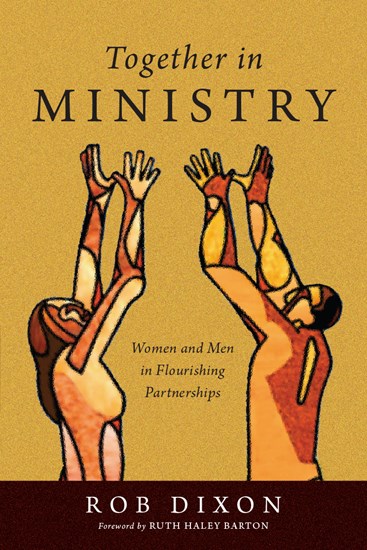Dixon, Rob. Together in Ministry: Women and Men in Flourishing Partnerships. Downers Grover, IL: InterVarsity Press, 2021, 176, $22, paperback.
Rob Dixon is an associate regional ministry director with InterVarsity Christian Fellowship/USA and senior fellow for gender partnership with the InterVarsity Institute. He is an adjunct professor at Fresno Pacific University and Fuller Theological Seminary and provides training on flourishing mixed-gender ministry partnerships for numerous organizations around the country.
Together In Ministry is the culmination of Dixon’s twenty-seven years of ministry experience and four years of focused doctoral research in mixed-gender ministry partnerships. Dixon’s book “rests on the premise that women and men are designed to partner together in the work of fulfilling God’s mission on earth,” as laid out in the first two chapters of Genesis (p. 2). His thesis states that it is necessary and possible to embrace this Genesis picture in order to have flourishing mixed-gender ministry partnerships. Drawing on years of hands-on experience, research interviews, focus groups, and a survey of theology and church history, Dixon lays out a model for ministry partners that helps each person find a profound sense of personal satisfaction and accomplish their ministry goals (p. 17).
His research has led him to focus on ten attributes that need to be present for a mixed-gender ministry partnership to flourish. Dixon divides these attributes into three domains (p. 22). First, the inner life domain is comprised of the attributes of an authentic learner’s posture, a shared theological conviction of gender equality, and an awareness of gender brokenness. Next, the domain of community culture is populated with attributes including a vision for freely shared power, difference for the sake of mission, a value for holistic friendships, and a corporate sensitivity to adverse gender dynamics. The final domain is intentional practices, containing the last three attributes of abundant communication, contextualized boundaries, and public affirmation and modeling.
The bulk of the book is spent fleshing out each of the three domains, with individual chapters devoted to each of the ten attributes. Dixon begins each chapter with a survey of examples from Scripture and pertinent testimony from interviewees and focus groups that helped him develop and define each attribute. He then describes the benefits of exhibiting each of these attributes and the barriers that keep these attributes from being present in ministry partnerships between men and women. He rounds out each chapter with tactics for how to cultivate these attributes, leading to a well-rounded, flourishing mixed-gender ministry partnership.
Dixon anchors his organizational model in the context of church history and theology, resting on the premise that men and women are designed to partner together to fulfill God’s mission, as seen in Genesis 1. Dixon spends a good portion of each chapter explaining the principles of each attribute based on what he has learned from Scripture. While his interpretation of Scripture is unapologetically egalitarian, the purpose of this book is not strictly to convince the reader to adopt an egalitarian posture. It is to provide well-researched, practical guidance for creating a healthy staff culture in ministries and churches, one that focuses less on what women cannot do and more on what men and women can accomplish together to advance the Gospel.
Dixon approaches each attribute with humility and care, neither berating men for their perceived slights nor coddling women for their perceived inabilities. He also does not take a genderless approach. Many of his attributes focus on embracing the differences between men and women and encouraging the difficult work of inspecting some of the sinful behaviors that arise from how we think about these differences. Where Dixon does promote commonality is in areas involving the convictions that we hold and the power that we wield, with attributes like a shared theological conviction of gender equality and a vision for freely shared power.
Attributes with titles like awareness of gender brokenness and corporate sensitivity to adverse gender dynamics can initially be challenging for some readers, but behind the modern jargon is the conventional wisdom found in the process of sanctification. It has merely been applied to the specific context of men and women working together in ministry, from the examination of one’s own brokenness and how it leads men and women to sin against each other to how we learn to live and work with one another in the unity of fellowship through discipleship and spiritual formation within a community of believers. Even if some of the terms seem new or unwieldy to the reader, the underlying concepts can still be beneficial.
Admittedly, much of what Dixon teaches in these chapters can be summed up, as he puts it, in the pursuit of courageous intentionality (p. 151). That is also where the difficulty lies. It requires setting aside time to do things like debriefing during a staff meeting and putting in the effort to learn from the other person. It requires courage to be honest with one another when something is not working in the partnership and set appropriate boundaries and expectations. Regardless of the setting, if men and women are working together in a ministry context, applying these attributes can lead to personal satisfaction in their God-given calling and joyfully advancing the mission.
Christine Ellis
First Baptist Starkville
Starkville, MS





